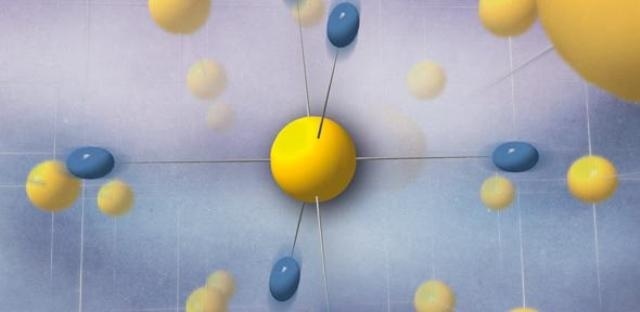Apr 11 2016
Research by the UPV/EHU-University of the Basque Country and DIPC-Donostia International Physics Center has concluded that the quantum effects explain why hydrogen sulphide is a superconductor at record-breaking temperatures
 This is a structure with symmetric hydrogen bonds induced by the quantum behavior of the protons, represented by the fluctuating blue spheroids. CREDIT: UPV/EHU
This is a structure with symmetric hydrogen bonds induced by the quantum behavior of the protons, represented by the fluctuating blue spheroids. CREDIT: UPV/EHU
According to the results of a piece of international, collaborative research led by the UPV/EHU and DIPC, the Sorbonne University of Paris, and the University of Rome ‘La Sapienza', and published today in the prestigious journal Nature, the quantum behaviour of hydrogen affects the structural properties of hydrogen sulphide, a compound that when subjected to extremely high pressures has superconducting properties at the highest temperature detected so far. This is a great step forward in the quest for room-temperature superconductors, which are highly sought after and still not obtained.
The theoretical results of a piece of international research published in Nature, whose first author is Ion Errea, a researcher at the UPV/EHU and DIPC, suggest that the quantum nature of hydrogen (in other words, the possibility of it behaving like a particle or a wave) considerably affects the structural properties of hydrogen-rich compounds (potential room-temperature superconducting substances). This is in fact the case of the superconductor hydrogen sulphide: a stinking compound that smells of rotten eggs, which when subjected to pressures a million times higher than atmospheric pressure, behaves like a superconductor at the highest temperature ever identified. This new advance in understanding the physics of high-temperature superconductivity could help to drive forward progress in the search for room-temperature superconductors, which could be used in levitating trains or next-generation supercomputers, for example.
Superconductors are materials that carry electrical current with zero electrical resistance. Conventional or low-temperature ones behave that way only when the substance is cooled down to temperatures close to absolute zero (–273 °C o 0 degrees Kelvin). Last year, however, German researchers identified the high-temperature superconducting properties of hydrogen sulphide which makes it the superconductor at the highest temperature ever discovered: –70 °C or 203 K.
The structure of the chemical bonds between atoms changes
In classical or Newtonian physics it is possible to measure the position and momentum of a moving object to determine where it is going and how long it will take to reach its destination. These two properties are inherently linked. However, in the strange world of quantum physics, it is impossible, according to Heisenberg's uncertainty principle, for specific pairs of observable complementary physical magnitudes of a particle to be known at the same time.
Hydrogen is the lightest element in the periodic table, so it is an atom that is very strongly affected by quantum behaviour. Its quantum nature affects the structural and physical properties of various hydrogen compounds. An example is high-pressure ice where quantum fluctuations of the proton lead to a change in the way the molecules are held together, due to the fact that the chemical bonds between atoms end up being symmetrical. The researchers in this study believe that a similar quantum hydrogen-bond symmetrisation occurs in the hydrogen sulphide superconductor.
The researchers have formulated the calculations by considering the hydrogen atoms as quantum particles behaving like waves, and they have concluded that they form symmetrical bonds at a pressure similar to that used experimentally by the German researchers. So they have succeeded in explaining the phenomenon of superconductivity at record-breaking temperatures because in previous calculations hydrogen atoms were treated as classical particles, which made impossible to explain the experiment. All this highlights the fact that quantum physics and symmetrical hydrogen bonds lie behind high-temperature conductivity in hydrogen sulphide.
The researchers are delighted that the good results obtained in this research show that quantitative predictions and computation can be used with complete confidence to speed up the discovery of high-temperature superconductors. According to the calculations made, the quantum symmetrisation of the hydrogen bonds has a great impact on the vibrational and superconducting properties of hydrogen sulphide. "In order to theoretically reproduce the observed pressure dependence of the superconducting critical temperature, the quantum symmetrisation needs to be taken into account," explained Ion Errea, the lead researcher in the study.
This theoretical study shows that in hydrogen-rich compounds, the quantum motion of hydrogen can strongly affect the structural properties (even modifying the chemical bonding), as well as the electron-phonon interaction that drives the superconducting transition.
In the view of the researchers, theory and computation have played a key role in the search for superconducting hydrides subjected to extreme compression. And they also pointed out that in the future an attempt will be made to increase the temperature until room-temperature superconductivity is achieved while dramatically reducing the pressures required.
Additional information
This international research was carried out with the collaboration of researchers from the UPV/EHU-University of the Basque Country and Donostia International Physics Center (DIPC), the UPMC Université Paris 06 (Sorbonne), the University of Cambridge (Cavendish Laboratory), the Jiangsu Normal University, the Carnegie Institution of Washington, Jilin University, and the University of Rome ‘La Sapienza'.
The lead researcher in the study was Ion Errea (Donostia-San Sebastian, 1984); he is a PhD holder in Physics and is currently a researcher at DIPC and a lecturer in the UPV/EHU's Department of Applied Physics.
Bibliographical reference
I. Errea, M. Calandra, C. J. Pickard, J. R. Nelson, R. J. Needs, Y. Li, H. Liu, Y. Zhang, Y. Ma, y F. Mauri. "Quantum hydrogen-bond symmetrization in the superconducting hydrogen sulfide system". Nature (2016). DOI: 10.1038/nature17175.